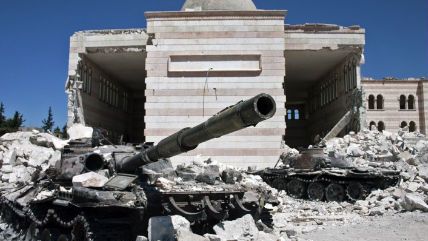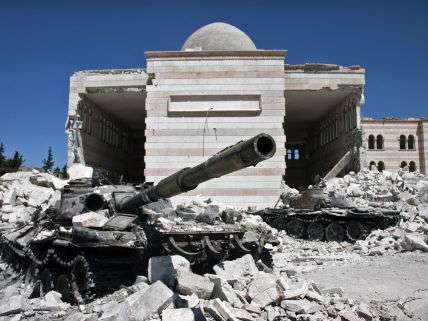Refugee Crisis Isn't Just About Aleppo, or Even Syria for that Matter
Lazy metonym that provides convenient framing.


Libertarian presidential nominee Gary Johnson finally got his viral moment. Unfortunately for him, it was a gaffe. Asked on Morning Joe what he would, if he were elected, "about Aleppo," Johnson asked what "an Aleppo" was. The interviewer explained that Aleppo was the "epicenter of the refugee crisis."
Not quite.
Had the interviewer, Mike Barnicle, called Aleppo the "epicenter of the Syrian refugee crisis," he would be less incorrect, but still incorrect. Aleppo may have since the start of the Syrian civil war become the most well-known Syrian city in the U.S. outside of the Syrian capital of Damascus (The New York Times, in reporting on Johnson's flub, even incorrectly identified Aleppo as the capital of Syria) and may be the site of some of the most intense fighting, but the crisis in Syria involves the entire country. Aleppo is a major city which has seen fighting between government forces and various anti-government forces ranging from the so-called moderate and U.S.-backed Free Syrian Army to the Islamic State (ISIS). But ISIS controls large swaths of Syrian territory and government forces are engaged in fights around the country.
Because of the prominence of the Syrian civil war in international news, Syrian refugees are the most identifiable refugees today. But the refugee crisis is not fueled exclusively, or even primarily, by Syrian refugees. For example, in 2015, while more refugees in Europe came from Syria than anywhere else, they made up less than half of the refugee total. The second and third most common place of origin for refugees in Europe applying for asylum for the first time in 2015 were Afghanistan and Iraq. That fact suggests the reason why so many Western observers, and especially American "thought leaders", prefer to talk about a Syrian refugee crisis than a wider regional refugee crisis—U.S. involvement in Syria, such as it is, is far less obvious and intense than U.S. involvement in Afghanistan and Iraq was and continues to be.
Before President Obama committed in the last year to accepting 10,000 of the 4 million refugees produced by the Syrian conflict, the U.S. spent the first several years of the Syrian civil war accepting virtually no refugees from Syria out of the about 60,000 to 80,000 or so refugees accepted into the U.S. each year. In fiscal year 2014, for example, the U.S. accepted 105 Syrian refugees, and in fiscal year 2015, the first year in which Syrian refugees became a prominent enough issue on the political stage to yield some kind of action, 1,682. Neither did the general flow of refugees become a contentious issue until the last year. The U.S. has been accepting tens of thousands of Muslim refugees, largely from countries in which U.S. intervention has helped create an environment where terrorism thrives. In fiscal year 2015, the U.S. accepted 12,676 refugees from Iraq, and 8,858 from Somalia. The only country from which more refugees came was Burma.
It's more convenient for the foreign policy establishment and its apologists to talk about the Syrian refugee crisis, because it's easier to imply (however incorrectly) that it is the result of U.S. inaction. The large numbers of refugees from countries the U.S. has helped destabilize make those kinds of implications, and the case in favor of even more U.S. intervention, harder to make.


Show Comments (45)